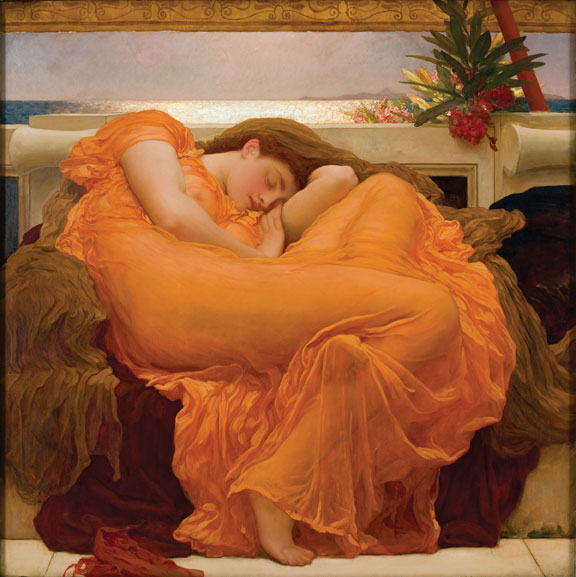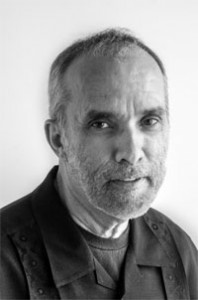« Features
The Nets With Which We Try To Capture Art And Beauty
Let me begin by confessing considerable agnosticism about the essence and/or definition of art and beauty. I shall not attempt to deal with that issue in this essay. Rather, I want to look at some of the nets or narrative stories about art and beauty experiences that some scientists and some defenders of Romanticism employ in the culture war of scientism vs. non-scientism.
In his book The Science Delusion, Curtis White has laid out the general landscape of this conflict. While not opposed to science per se, White argues that bio-mechanical reductionism in many scientific quarters has become a kind of dogmatic model or ideology that he labels scientism. The advocates of scientism, he says, have gained a widespread voice, if not a monopoly, in the way that we look at physical phenomena and human nature, as well as how we understand art and beauty experiences. The model is found in the writings of the so-called New Atheists, including Richard Dawkins, the late Christopher Hitchens, Sam Harris, Daniel Dennett, and others. Briefly, the model articulates the view that the universe is a thoroughly physical phenomenon governed by the laws of physics and that humans (specifically, human brains) are bio-mechanical computers utterly reducible to the workings of neurons, DNA, and a variety of neurotransmitters. White also claims that this relentless empiricism involves a dim view of statements about art and beauty experiences, either regarding them as completely emotive utterances or irrelevant narratives that have been superseded by the inevitable march of scientific methodology, a view not unlike that held by the Logical Positivists who attempted to reform philosophy in the 1930s by ‘disabusing’ it of its untestable propositions.

The Art Instinct. Beauty, Pleasure, and Human Evolution, by Denis Dutton. Edited by Bloomsbury Press, 2009.
Advocates of non-scientism (including White himself) maintain that physical or bio-mechanical reductionism has serious conceptual problems: it is based on over-extended and unprovable metaphors—for example that the brain is like a physical computer and conscious experience is completely reducible to the accumulated effects observable on MRIs; it thereby confuses the correlate of consciousness with consciousness itself; and it falsely claims that art and beauty experiences are really nothing more than brain experiences as causally governed by DNA, protein robots, and various locations of brain geography and the action of neurotransmitters. White believes there are other problems connected with scientism as well, but I want to focus especially on the latter claim about the reducibility of art and beauty experiences to neurophysiology.
White notes the irony of how some scientists speak of the ‘wondrous beauty’ of the physical order of the universe and also of the human brain as a product of materialistic evolution. Such effusive language is not uncommon and yet, says White, how can scientists give a rational, self-consistent account of their use of this language? Many of the New Atheists believe that art is functionally dead or irrelevant to the question of true reality and that any kind of beauty experience—in particular the qualia or felt-quality of said experience—is reducible to the ‘jiggling of atoms’ and ’squirting’ of brain chemicals. But such an understanding of the beauty experience in effect eliminates it as culturally or symbolically meaningful. Thus, according to White, the purveyors of scientism are at best self-referentially inconsistent in their language, or at worst attempting to mislead us by means of a monolithic, materialistic worldview that ultimately cannot be proven.

The Science Delusion: Asking the Big Questions in a Culture of Easy Answers, by Curtis White. Edited by Melville House, 2014.
By contrast, those in the tradition of Romanticism hold that the inner life of consciousness is autonomous and irreducible to mere brain states, and that narratives about art and beauty experiences are central to the human search for meaning. White finds his inspiration at this point in 19th Century German idealism, especially the philosophy of Friedrich Schelling. In The System of Transcendental Idealism, Schelling attempted to synthesize empiricism’s focus on matter with idealism’s focus on consciousness and the observer self. His arguments, as summarized by White, are complex and I have no desire to oversimplify them, but essentially he suggested that we can only speak meaningfully of experiencing sensations caused by the physical world if there is a perceiving self. The originary form of this perceiving self Schelling called the Absolute Self, a sort of common mind shared by all humans which works through various stages or ‘moments’ of development leading from universal consciousness to individuated human consciousness and the awareness of the world of sensations and things to the highest stage in which the ‘I am’ of the self and the ‘It is’ of the world become synthesized and reciprocally conditioned by one another.
In terms of his attitude about art and beauty experiences, Schelling set the stage for the later Romantics with his belief that such experiences express the synthesis of self and world in the most symbolic and culturally significant ways, especially including music, literature, poetry, and visual art. Thus, for him, art and beauty experiences are vital and irreducible aspects of human being-in-the-world and our quest for significant meaning in existence. Schelling’s views are therefore the perfect contra pose to the rampant scientism that White skillfully identifies and critiques.
What, then, are we to make of this cultural agon of scientism vs. non-scientism? Again, without wishing to oversimplify such a complicated debate, I would suggest that there are conceptual difficulties on both sides that have not been resolved as yet. The following are some preliminary and tentative thoughts.

Johannes Vermeer (1632-1675), The Girl with a Pearl Earring, circa 1665, oil on canvas, 18.3” x 15.7.” Royal Picture Gallery Mauritshuis. Photo: www.geheugenvannederland.nl. Courtesy https://commons.wikimedia.org.
First, it is very unclear that bio-mechanical reductionism has offered us anything close to an adequate definition or understanding of matter as such. It is all well and good to assert (usually dogmatically) that the human brain is nothing more or less than the product of material evolution and that it constitutes a collection of bio-chemicals. But what is matter? The mechanistic view as offered by most contemporary neuroscientists and the New Atheists as well is likely to be revealed as rather primitive or plainly false in the wake of future work in quantum physics. Actually, this has been apparent for some time now inasmuch as quantum phenomena are anything but mechanistic. But I have in mind here the current plethora of theories surrounding the adequacy of the Standard Model of particle physics, the discovery of new particles by accelerators such as the Large Hadron Collider, and the current disagreements over a mathematically viable and empirically verifiable unified field theory. It seems safe to say that we are only beginning to understand what matter is. Many scientists now believe that discussions of matter at the quantum level must involve discussions of the ‘observer effect’ and the role of some kind of consciousness in establishing what matter is in its most fundamental form. New paradigms await, undoubtedly ones that will not be reductive or eliminative about the qualia of conscious experiences in general and those of art and beauty in particular.
Additionally, the defenders of scientism and its eliminative attack on art and beauty experiences might do well to consider the late Denis Dutton’s book The Art Instinct: Beauty, Pleasure, and Human Evolution. There are, of course, conceptual problems connected with evolutionary aesthetics-for example, the lack of relevant fossil records-but Dutton’s book is a sustained and fascinating attempt to show how something like an art instinct may have arisen out of the thousands of developmental generations of the Pleistocene Period. Dutton’s arguments are subtle and non-reductionistic. Through myriad examples, he suggests that the human desire to make and appreciate art and beauty is not merely conditioned by culture but also has deep evolutionary roots in natural and sexual selection. For instance, Dutton argues that proto-narrative skills during the Pleistocene Period that had survival value in terms of hunting, group solidarity, and sexual selection also gradually established a sort of early predisposition for the making of verbal forms of art, such as story-telling. Dutton thus corrects an important omission in scientism’s dismissive attitude toward art and beauty experiences; namely, the failure to explore a holistic, non-mechanistic account of these experiences within the parameters of evolutionary theory itself.
As White indicates, there are other conceptual and cultural problems with scientism, but I want to turn the focus for a moment to Romanticism. In many historical manifestations (such as that found in Schelling), the question of the nature of consciousness is looming and unresolved. What is consciousness? What is Schelling’s Absolute Self? And is it true to say that consciousness is sui generis and irreducible? Just as we do not yet deeply know the nature of matter, we may say the same about consciousness, and especially the qualia of art and beauty experiences. Certainly, a great virtue of the Romantics is that they do not wish to ignore the lived aspect of human experience, but the defenders of non-scientism sometimes show a dogmatic aspect on their side of the culture war. That is, they can be dismissive of any scientific attempt to address the nature and origin of conscious experiences. This is surely a closed-minded mistake. Useful scientific research programs do not have to be bio-mechanically reductionistic.
The current culture war between scientism and non-scientism as to the nature of art and beauty experiences is not unlike Jastrow’s famous duck/rabbit image. As used by Wittgenstein, the image embodies a conceptual or perceptual shift of focus: looked at in terms of one perceptual set, only the duck is seen; looked at from another set, only the rabbit is seen. It is impossible, Wittgenstein thought, to see both simultaneously. But if we apply this imagistic metaphor to scientism and non-scientism, we often find only entrenchment and an unwillingness on each side to consider the other side. White is correct: some kind of rapprochement is vital. And Schelling’s ideas could be fruitful. What we need perhaps is an intellectual paradigm that is, as it were, an ‘empirical idealism’ whereby whole new categories for understanding the complex relations between consciousness and matter can be postulated and explored. The notion of ‘conscious matter’ may one day be a common and verifiable tenet in science such that there will no longer be the reign of a simple-minded scientism, largely under the influence of Galilean methodology, that denies the cultural importance of art and beauty experiences.

Frederic Leighton (1830-1896), Flaming June, 1895, oil on canvas, 47 3/8” x 47 3/8”. Museum of Art of Ponce, Ponce, Puerto Rico. Photo: Artrenewal.org. Courtesy https://commons.wikimedia.org.
Interestingly, when scientists speak of the beauty of equations, the beauty of cosmic pictures from the Hubble telescope, the beauty of new theories and new empirical discoveries about the world, they are, says White, speaking about beauty as a form of lived and exciting dissonance: old theories and facts colliding with new and better theories and facts. There is truly something glorious and beautiful about the new visions science is giving us of the cosmos and human nature. How strange and sad it is when such visions are virtually dissolved by an eliminative materialism that only sees clusters of neurons lighting up in various parts of the brain.
John Valentine is a professor of philosophy and has taught at the Savannah College of Art and Design since 1990. His publication credits include the textbook Beginning Aesthetics (McGraw-Hill, 2007), as well as articles in the Florida Philosophical Review, the Southwest Philosophy Review, the Journal of Philosophical Research, the Journal of Speculative Philosophy and The Philosopher, as well as poetry published in various journals, including The Sewanee Review, The Midwest Quarterly and the Southern Poetry Review, among others, as well as six chapbooks of poetry.




































Leave a Reply
You must be logged in to post a comment.